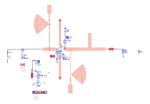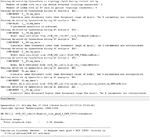rijubrata
Newbie level 5
I am designing a FET based oscillator (fo = 6 GHZ) in ADS2014. I simulated the Bias Tee sections and output matching in momentum in 5 - 8 GHz frequency range. In momentum analysis, I am not getting warnings/errors other than internal port being changed from TML to NONE calibration.
After momentum analysis is over, I generate EM model and do co-simulation with FET using Harmonic Balance simulation.I used DC_Block and DC_Feed in the FET terminals accordingly.
I cant understand from where I am getting the following list of warnings, would that mean the measured result will differ from the simulated one?
I have added the warnings and the picture of the circuit that I got in co-simulation
After momentum analysis is over, I generate EM model and do co-simulation with FET using Harmonic Balance simulation.I used DC_Block and DC_Feed in the FET terminals accordingly.
I cant understand from where I am getting the following list of warnings, would that mean the measured result will differ from the simulated one?
I have added the warnings and the picture of the circuit that I got in co-simulation

